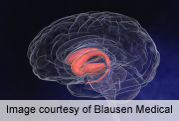
WEDNESDAY, June 20 (HealthDay News) — Deep brain stimulation, a treatment that involves the surgical implantation of wires in the brain that deliver an electrical current, could improve motor functions for at least three years in people with advanced Parkinson’s disease, new research suggests.
The study is the longest-running comparison of the effects of stimulating the two different areas of the brain that are the most common sites for implantation.
Researchers randomly assigned 159 patients with Parkinson’s disease to receive deep brain stimulation either in an interior area of the brain called the subthalamic nucleus (STN) or in a less studied and larger exterior brain area called the globus pallidus interna (GPi). The two groups had similar improvements in common Parkinson’s symptoms, such as tremors, muscle rigidity and speech, and those improvements held 36 months after the surgery.
The study was published online June 20 in Neurology.
“We’ve demonstrated that either [area] improves motor function,” said study author Frances Weaver, director of the Center for Management of Complex Chronic Care at the Hines VA Hospital, in Illinois.
“There was primarily a focus on stimulating the STN area because stimulating that area could reduce the amount of medication that an individual was taking for Parkinson’s,” Weaver explained.
In addition, as the authors wrote, there are more data available supporting the long-term benefits of STN than GPi stimulation. A 2010 study reported that motor improvements associated with STN stimulation were sustained for up to 10 years in a small group of patients.
“Our data really suggest that [health care] providers should think about both targets and what else is going on and not just arbitrarily pick one over the other,” Weaver said. For example, a Parkinson’s patient who is having mental problems might do better with GPi stimulation because it has been associated with fewer cognitive side effects, she explained.
About 1 million people in the United States have Parkinson’s disease, and about 5 percent of them are candidates for DBS, said Dr. Mark Stacy, a professor of neurology at Duke University Medical Center in Durham, N.C.
Deep brain stimulation, which is used to treat a number of conditions including depression, Alzheimer’s and headaches, is best used for Parkinson’s patients who are no longer benefiting from Parkinson’s medications, Stacy said. Although each Parkinson’s case is different, it generally takes a patient between five and 25 years to progress to this point, he added.
The most common side effects that Stacy discusses with his patients are pain associated with the device, as well as numbness and tingling, which can usually be controlled by adjusting the electrical current. There is also a small risk of stroke and bleeding associated with the surgery, Stacy said.
In the current study, 89 people were randomly assigned to receive GPi stimulation while 70 people received STN stimulation. Their average age was 60.
Nearly all of the patients were taking at least one medication for Parkinson’s, Weaver said, and the most common was levodopa.
The researchers included the same participants as in an earlier study they did comparing the effects of GPi and STN stimulation two years after implantation. The previous research found similar motor benefits from targeting these two sites.
For the current study, the researchers determined the disease score — based on motor function, including tremors, muscle rigidity, gait and speech, as well as mood and ability to carry out daily activities — for the two groups at 36 months. The score is based on a 108-point scale where the higher the score, the more severe the disease.
The researchers first measured the disease score in patients who had not taken their medication since the previous day. For the group receiving GPi stimulation, the average score was 27 compared to their baseline score of 41, which was determined before they received the implant. The disease score for the STN group dropped from 42 to 30. The authors determined that the improvement in these groups was not statistically different.
The researchers also evaluated the disease in patients who were taking their normal medication as well as receiving stimulation at 36 months. They found that the patients with GPi stimulation, unlike the STN group, were still improved compared to their baseline score.
“You would expect some decline because the disease progresses over time, but what we saw was that that didn’t seem to happen with GPi,” Weaver said.
“It was a surprise, at least to me, that the GPi group did as well as the STN group,” said Stacy, who generally targets the STN site in his practice. “This further suggests that there is more reason to look into the GPi site on the long term.”
The rate of side effects was similar between the two groups, and most of them occurred within six months of surgery, Weaver said.
In addition, the researchers found that GPi stimulation was associated with improvements in mental ability, based on measures such as verbal learning, after three years while mental scores for the STN group were lower than baseline.
The difference could be because targeting GPi stimulates a larger area of the brain than STN or has some off-site effects, Weaver said.
However, the researchers did not see improvements in aspects like emotional well-being or social support in either group after three years.
Quality of life often does not improve in this type of study, Stacy said. “[But] I think if you asked a patient, many would say, ‘Yes, my quality of life is better after surgery,'” he noted.
Weaver and her colleagues are now following patients with Parkinson’s for seven or nine years after DBS surgery. “Ideally they ought to have that stimulator for the rest of their lives if it continues to be helpful to them, so we want to look longer to see what happens,” she said.
More information
To learn more about Parkinson’s disease, visit the Parkinson’s Disease Foundation.

